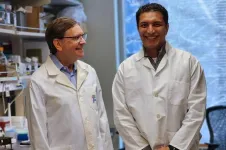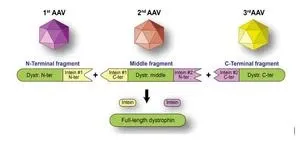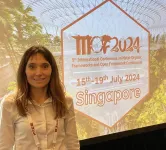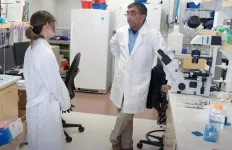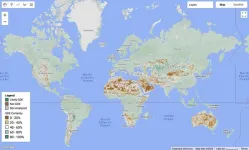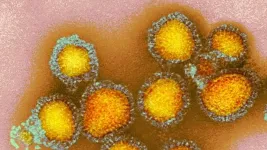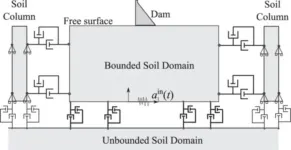(Press-News.org) A new gene therapy treatment for Duchenne muscular dystrophy shows promise of not only arresting the decline of the muscles of those affected by this inherited genetic disease, but perhaps, in the future, repairing those muscles.
The UW Medicine-led research focuses on delivering a series of protein packets inside shuttle vectors to replace the defective DMD gene within the muscles. The added genetic code will then start producing dystrophin, the protein lacking in patients with muscular dystrophy.
Currently, there is no cure for the disease and available treatments and drugs only slow down the disease. In the case of Duchenne muscular dystrophy – the topic of this study – patients, all males because the gene is on the X chromosome, begin exhibiting symptoms around age four and usually die their 20s or 30s.
Findings on the new gene therapy were published today in Nature.
UW Medicine neurologist and geneticist, Dr. Jeffery Chamberlain, the study’s senior author, has worked his entire career on finding therapeutics and seeking a cure for muscular dystrophy. He is director of the Wellstone Muscular Dystrophy Research Center and is the McCaw endowed chair in muscular dystrophy at the University of Washington School of Medicine. The research project was led by molecular biologist Dr. Hichem Tasfaout working in the Chamberlain lab.
What has stymied researchers in the past is the gene which needs to be fixed is the largest gene in nature, Chamberlain noted. Up until now, there was no way to deliver adequate protein fixes into the muscles..
“Think of having a king-sized bed delivered that you can’t get through your door,” he said.
The new method, which has had success on mouse models, uses a series of adeno-associated viral vectors or AAVs, which are tiny shuttles derived from a virus that are being used to deliver gene therapies into human cells. Instead of one AAV, this gene therapy uses a series of AAVs which take parts of the therapeutic protein inside the muscles, along with embedded instructions to begin assembling the necessary genetic fix once within the body.
Back to the king bed analogy again, not only are the parts taken in piece by piece, but the delivery workers begin assembling the bed once inside the house. The next step for the therapy is human trials, which should begin in approximately two years, Chamberlain said.
In the lab, this method has not only halted further progression of the disease, but it has been able to reverse much of the pathology associated with dystrophy. Eventually, Chamberlain and Tasfaout hope that this method might lead to a reversal of the muscle wasting and restore normal health of the muscle tissue.
The latest approach also uses a new type of AAV vector that allows the use of lower doses and therefore may reduce or eliminate some of the side effects of previous approaches, Chamberlain said.
“When we infuse a large dose of these delivery shuttles, the body goes 'Whoa, what’s going on here?'” he said.
This then kicks off an immune response which can damage the heart or liver, he explained.
Chamberlain remembers watching the Jerry Lewis Telethon as a kid and wanting to help those children. That feeling may have been a spark for the passion which eventually guided his career. He ended up being an expert who discussed the science of therapies on the telethon about seven times.
“When you meet families and patients it just inspired me to work that much harder,” he said.
The research was largely supported by the Muscular Dystrophy Association, with gifts raised via a series of fundraisers hosted by former Seattle Mariner Edgar Martinez.
END
New gene therapy for muscular dystrophy offers hope
The research focuses on delivering a set of protein packets to replace defective genes within the muscles.
2024-07-17
ELSE PRESS RELEASES FROM THIS DATE:
Scientists bridge the 'valley of death' for carbon capture technologies
2024-07-17
A major obstacle for net zero technologies in combatting climate change is bridging the gap between fundamental research and its application in the real world.
This gap, sometimes referred to as ‘the valley of death’, is common in the field of carbon capture, where novel materials are used to remove carbon dioxide from flue gasses produced by industrial processes. This prevents carbon from entering the atmosphere, helping to mitigate the effects of climate change.
Chemists have proposed and ...
Genome recording makes living cells their own historians
2024-07-17
Genomes can now be entrusted to store information about a variety of transient biological events inside of living cells, as they happen, like a flight recorder collecting data from an aircraft.
“Our method, which goes by the acronym ENGRAM, aims to turn cells into their own historians,” said Dr. Jay Shendure, a professor of genome sciences at the University of Washington School of Medicine and scientific director of the Brotman Baty Institute for Precision Medicine. Shendure led the effort, together with Wei Chen, a former graduate student, and Junhong Choi, a former postdoctoral fellow. Junhong ...
USC Schaeffer Institute launches new initiative to improve public policy through behavioral science
2024-07-17
The USC Schaeffer Institute for Public Policy & Government Service announced a new initiative today that leverages behavioral science to create more effective public policy.
The Behavioral Science & Policy Initiative at the USC Schaeffer Institute will conduct research to understand people’s beliefs and behaviors to create policies and communication that better fit people’s needs. The initiative will focus on policy topics such as climate change, health, and food insecurity.
“We want to help policymakers make a difference,” said Wändi Bruine de Bruin, the initiative’s ...
Groundwater is key to protecting global ecosystems
2024-07-17
(Santa Barbara, Calif.) — Where hidden water tables meet the Earth’s surface, life can thrive even in the driest locations. Offering refuge during times of drought, shallow groundwater aquifers act like water savings accounts that can support ecosystems with the moisture required to survive, even as precipitation dwindles. As climate change and human water use rapidly deplete groundwater levels around the world, scientists and policy makers need better data for where these groundwater-dependent ecosystems exist.
Now, a new study maps ...
A new approach to accelerate the discovery of quantum materials
2024-07-17
– By Michael Matz
Researchers at the Department of Energy’s Lawrence Berkeley National Laboratory (Berkeley Lab) and several collaborating institutions have successfully demonstrated an innovative approach to find breakthrough materials for quantum applications. The approach uses rapid computing methods to predict the properties of hundreds of materials, identifying short lists of the most promising ones. Then, precise fabrication methods are used to make the short-list materials and further ...
Influenza viruses can use two ways to infect cells
2024-07-17
Most influenza viruses enter human or animal cells through specific pathways on the cells’ surface. Researchers at the University of Zurich have now discovered that certain human flu viruses and avian flu viruses can also use a second entry pathway, a protein complex of the immune system, to infect cells. This ability helps the viruses infect different species – and potentially jump between animals and humans.
The majority of type A influenza viruses circulating in birds and pigs aren’t normally a health ...
Engineering resilience: Advanced FEM enhances earthquake impact assessment
2024-07-17
In a significant advancement for geotechnical engineering, a refined space-time finite element method (v-ST/FEM) has been introduced to tackle the complex dynamics of soil-structure interaction during seismic events. This new approach allows for more accurate simulations of the response of earth structures to earthquake vibrations, marking a crucial step in improving infrastructure resilience against natural disasters.
Designing structures like dams, tunnels, and embankments to withstand transient loads from sources such as earthquakes, high-speed trains, and explosions requires robust dynamic soil-structure interaction (SSI) analysis. Traditional methods often fall short in handling ...
The Vps21 signaling pathway regulates white-opaque switching and mating in Candida albicans
2024-07-17
This study was led by Dr. Guanghua Huang (School of Life Sciences, Fudan University). The team discovered that the conserved Vps21 signaling pathway plays critical roles in the regulation of white-opaque switching and mating in Candida albicans, a major human fungal pathogen.
Candida albicans is able to cause cutaneous diseases as well as life-threatening systemic infections in humans. It has multiple cellular morphologies and can undergo transitions among different morphologies to adapt to environmental changes. White-opaque transitions represent a typical morphological phenotypic switching system ...
Autoantibodies behind lifelong risk of viral infections
2024-07-17
A new study shows that about two percent of the population develop autoantibodies against type 1 interferons, mostly later in life. This makes individuals more susceptible to viral diseases like COVID-19. The study, conducted by UZH researchers together with a USZ team, is based on an analysis of a large collection of historical blood samples.
Virus infections trigger the cells of the immune system to release type 1 interferons. These proteins act as early messengers that warn uninfected cells and tissues that a virus is spreading. This allows ...
Heritable chronic cholestatic liver diseases
2024-07-17
Chronic cholestasis, defined as the impairment of bile acid formation and/or flow persisting for more than six months, encompasses a broad spectrum of hepatobiliary disorders, both heritable and acquired. This review focuses on heritable causes of chronic cholestasis, which, although less common, present significant clinical challenges. Heritable chronic cholestatic liver diseases are typically diagnosed in childhood, but many cases present and persist into adulthood. This review aims to highlight the genetics, clinical pathophysiology, presentation, ...
LAST 30 PRESS RELEASES:
UVA’s Jundong Li wins ICDM’S 2025 Tao Li Award for data mining, machine learning
UVA’s low-power, high-performance computer power player Mircea Stan earns National Academy of Inventors fellowship
Not playing by the rules: USU researcher explores filamentous algae dynamics in rivers
Do our body clocks influence our risk of dementia?
Anthropologists offer new evidence of bipedalism in long-debated fossil discovery
Safer receipt paper from wood
Dosage-sensitive genes suggest no whole-genome duplications in ancestral angiosperm
First ancient human herpesvirus genomes document their deep history with humans
Why Some Bacteria Survive Antibiotics and How to Stop Them - New study reveals that bacteria can survive antibiotic treatment through two fundamentally different “shutdown modes”
UCLA study links scar healing to dangerous placenta condition
CHANGE-seq-BE finds off-target changes in the genome from base editors
The Journal of Nuclear Medicine Ahead-of-Print Tip Sheet: January 2, 2026
Delayed or absent first dose of measles, mumps, and rubella vaccination
Trends in US preterm birth rates by household income and race and ethnicity
Study identifies potential biomarker linked to progression and brain inflammation in multiple sclerosis
Many mothers in Norway do not show up for postnatal check-ups
Researchers want to find out why quick clay is so unstable
Superradiant spins show teamwork at the quantum scale
Cleveland Clinic Research links tumor bacteria to immunotherapy resistance in head and neck cancer
First Editorial of 2026: Resisting AI slop
Joint ground- and space-based observations reveal Saturn-mass rogue planet
Inheritable genetic variant offers protection against blood cancer risk and progression
Pigs settled Pacific islands alongside early human voyagers
A Coral reef’s daily pulse reshapes microbes in surrounding waters
EAST Tokamak experiments exceed plasma density limit, offering new approach to fusion ignition
Groundbreaking discovery reveals Africa’s oldest cremation pyre and complex ritual practices
First breathing ‘lung-on-chip’ developed using genetically identical cells
How people moved pigs across the Pacific
Interaction of climate change and human activity and its impact on plant diversity in Qinghai-Tibet plateau
From addressing uncertainty to national strategy: an interpretation of Professor Lim Siong Guan’s views
[Press-News.org] New gene therapy for muscular dystrophy offers hopeThe research focuses on delivering a set of protein packets to replace defective genes within the muscles.
